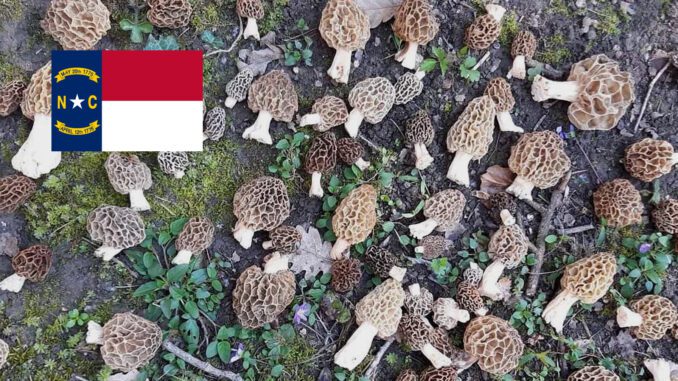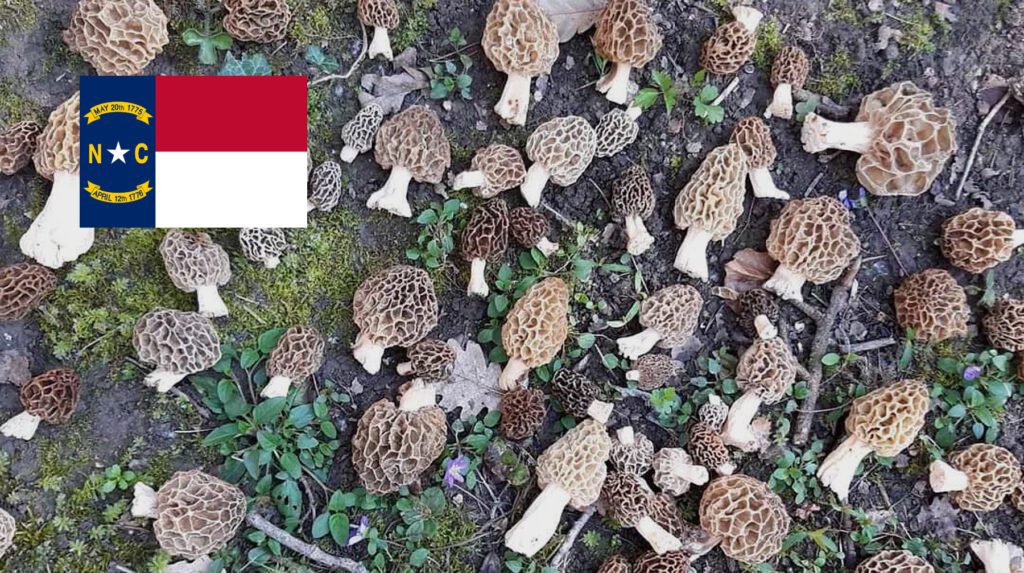
Are you wondering where to find mushrooms in North Carolina? You’ve come to the right place!
Discover where to go mushroom hunting in North Carolina.

Where To Find Mushrooms In North Carolina, The Method
Where to find mushrooms in North Carolina? Before we proceed, you need to understand one fundamental thing: there is a three-step method that always works for finding mushrooms:
- Firstly, you need to have a thorough understanding of the growth conditions of the mushroom you are seeking. Each mushroom, such as the morel or the chanterelle, requires specific soil type, acidity, host trees, altitude…
- Secondly, you need to have a comprehensive knowledge of North Carolina: its forests, soils, and topography (altitude, slope, aspect).
- Lastly, once you know which mushroom you are looking for, you simply need to find the right conditions in the right places in North Carolina.
By following the method described above, we have created maps that provide you with direct information on where to find mushrooms in North Carolina. Discover our maps on our website here and select the state “North Carolina” from the list.
Our maps are user-friendly and highly reliable. They will quickly guide you to the best spots for harvesting the most sought-after mushrooms (morels, chanterelles, lion’s mane, and more!).
Where To Find Mushrooms In North Carolina, Step By Step
1.Understanding The Growth Conditions
The morel, for example, grows in a calcareous and loamy soil with a pH level above 6. There are many host trees, but if you’re a beginner, look near ash or aspen trees. Morel mushrooms typically grow from late March to May, depending on the state.
On the other hand, the chanterelle thrives in highly acidic soil with a pH often below 4.5. There are also numerous host trees, but oak, beech, spruce, and fir are the most common. The chanterelle can grow at different times, but the prime season is typically between late September and mid-October.
We can observe that the growth conditions for the morel and the chanterelle are quite different! It is therefore crucial to know the specific conditions for each mushroom in order to find them successfully.
2. Geology, Forests, And Topography Of North Carolina
Why pay attention to the geology, forests, and topography of North Carolina? Simply because it is essential to understand the growth conditions of mushrooms in the field. What can we say about North Carolina?
The soils in North Carolina are mostly acidic, but it is possible to find areas with neutral to alkaline soil. As a result, various types of mushrooms can be found. To gain a better understanding of the soils in North Carolina, we recommend consulting a soil map specific to your region!
Regarding forests, the situation is similar. North Carolina harbors a diverse range of tree species scattered throughout its territory. This diversity creates favorable conditions for various types of mushrooms. However, determining which trees are found in specific locations can be challenging.
North Carolina’s topography includes mountains, coastal plains, and forests. Its diverse woodlands provide a habitat for various mushrooms, enticing foragers to explore and discover an array of fungi species, including edible varieties like chanterelles and reishi mushrooms.
So, where to find mushrooms with all this information?
3. Find Mushrooms With Our Maps!
Without a strong analysis of soils, forests, and topography, it can be challenging to quickly find the best mushroom spots in North Carolina. That’s why we’ve created maps that assess all these elements, allowing you to easily access the top mushroom locations with just a few clicks. Additionally, these maps also indicate the optimal time for mushroom hunting!
By using our maps, you can discover new edible mushroom species, explore new locations for your favorite mushrooms, and learn more about mushroom habitats!
To access our maps, visit our website at www.mushroomstalkers.com, then click on one of the green buttons on the page to view the maps, and select the state “North Carolina”. After payment, you’ll gain instant access to your map and start exploring the woods!
Leave a Reply